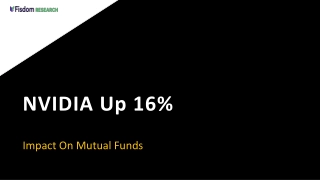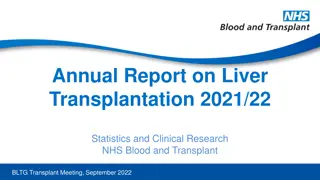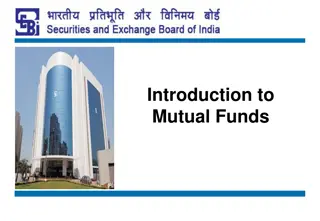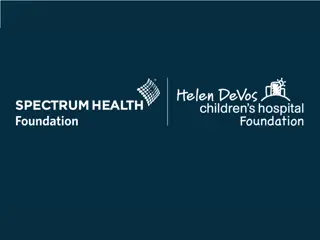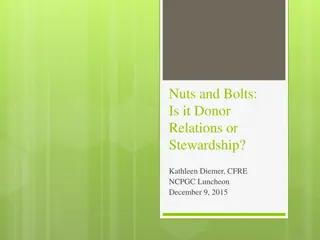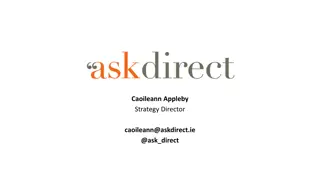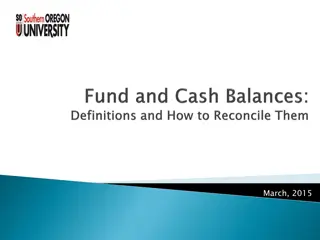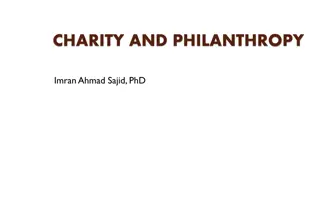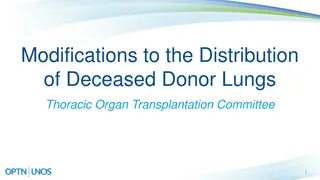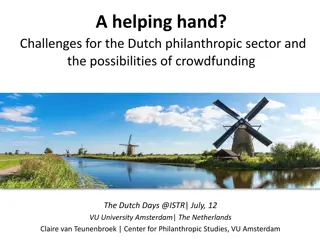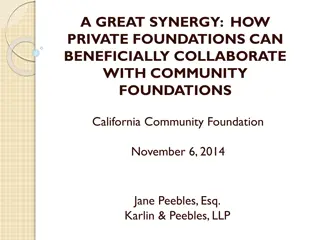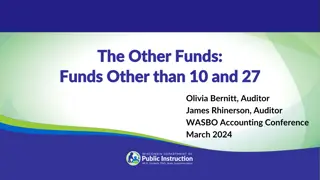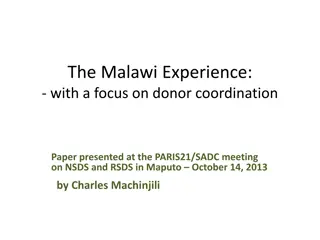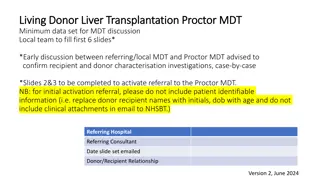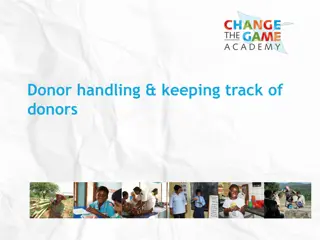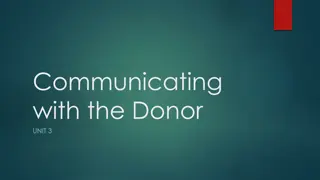The Impact of Donor Advised Funds on American Philanthropy
The rise of Donor Advised Funds (DAFs) has reshaped charitable giving in America, with organizations like Fidelity Charitable dominating the landscape. DAFs play a significant role in charitable donations, accounting for over 10% of all giving. This growth has sparked discussions on the effectiveness and implications of DAFs on philanthropy and society as a whole.
Download Presentation

Please find below an Image/Link to download the presentation.
The content on the website is provided AS IS for your information and personal use only. It may not be sold, licensed, or shared on other websites without obtaining consent from the author. Download presentation by click this link. If you encounter any issues during the download, it is possible that the publisher has removed the file from their server.
E N D
Presentation Transcript
IS AMERICAN PHILANTHROPY MAKING US POORER? THE BENEFITS AND COSTS OF DONOR ADVISED FUNDS James Andreoni Univ of California, San Diego and NBER
WHAT IS A DONOR ADVISED FUND? WHY SHOULD YOU CARE? What was the biggest Charity in America in 2016 and 2017?
WHAT IS A DONOR ADVISED FUND? WHY SHOULD YOU CARE? Rank Organization Mission Private Support 1 Fidelity Charitable Gift Fund Donor Advised Funds $5,393,562,395 2 United Way Worldwide Social Service $3,708,331,756 3 Feeding America Social Service $2,149,634,703
The Rapid Recent Growth of Fidelity Charitable $5.000 $4.500 $4.000 $3.500 $3.000 $2.500 $2.000 $1.500 $1.000 $0.500 $0.000 1995 2000 2005 2010 2015 Fidelity Charitable United Way
The Rapid Recent Growth of Fidelity Charitable 380% increase $5.000 $4.500 $4.000 $3.500 $3.000 $2.500 $3.65 Bil. Since 2010. $2.000 $1.500 $1.000 $0.500 $0.000 1995 2000 2005 2010 2015 Fidelity Charitable United Way
From Chronicle of Philanthropy list of 400 biggest charities for 2017, top 20 DAF Providers are coming to dominate charitable giving. Rank Organization Mission Private Support 1 Fidelity Charitable Gift Fund Donor Advised Funds $4,076,302,537 3 Donor Advised Funds $3,190,157,926 Goldman Sachs Philanthropy Fund 6 Schwab Charitable Donor Advised Funds $1,922,695,881 8 National Christian Foundation Donor Advised Funds $1,532,256,000 9 Silicon Valley Community Foundation Donor Advised Funds $1,383,888,000 10 Vanguard Charitable Endowment Donor Advised Funds $1,278,868,232 7 of top 20 14 National Philanthropic Trust Donor Advised Funds $1,006,225,727
MORE THAN 10% OF ALL GIVING PASSES THROUGH DAFS Average Annual DAF Contribution as a Percent of all Giving 12% In 2014 DAF Contributions as 10.3% a Percent all charitable deductions 10% 0.7% of donors have DAFs. 8% But DAFs yield 10% of all charitable deductions . 6% 4% 2% DAF Accounts as % of all SOI Filers 0.7% 0% 2007 2008 2009 2010 2011 2012 2013 2014
IF DAFS ARE SO POPULAR, WHY HAVE I NEVER HEARD OF THEM? Average Annual Giving 90000 Contributions to DAFS $82,400 According to the 2014 SOI, a household with a charitable deduction of $82,000 has an AGI of about $2 million per year. 80000 70000 60000 Grants from DAFS $51,200 50000 40000 30000 20000 Average Tax Deduction $ 6,100 10000 0 2007 2008 2009 2010 2011 2012 2013 2014
SO WHAT IS A DONOR ADVISED FUND? Begin with general tax policy in toward charitable giving
GIFTSOF CASH: 1. Taxpayers who itemize deductions can deduct gifts to a 501(c)(3) organization. 501(c)(3) refers to the IRS designation of organization type as charitable, not-for-profit An itemizerfiles a Schedule A, non-itemizers just claim the standard deduction. Only about 1/3 households are itemizers: generally have mortgage, property tax, or simply high state income taxes Example: Marginal tax rate is 35%. A $1000 deduction saves $350 in taxes. So the net cost to the donor is $1000-350 = $650. (Note: Not counting state taxes: E.g. In California save an additional $110 in state taxes.)
GIFTS OF NON-CASH ASSETS 1. It is easiest to think of giving appreciated shares of stock, but gifts also include artworks, real estate, collectables, and life insurance, to name a few. 2. Taxpayers who itemize can deduct the fair market value of the asset given to a 501(c)(3) organization. 3. Assets worth more than $5000 must be appraised. 4. Most charities have a rule that any assets received, especially publically traded stocks, are sold immediately. 5. Since the donor never liquidated the asset, the donor owes no Capital Gains Tax. 6. Since the charity is a non-profit, it owes no tax either. 7. NOTE: The difference between the donor or recipient liquidating the asset is just a day, but it can mean extensive tax savings for the donor.
GIFTS OF NON-CASH ASSETS, CONTINUED Example: Marginal tax rate is 35%. Donate shares of stock currently trading for $1000. Stocks were purchased in the past for $600, thus contain a $400 capital gain. The donor deducts $1000 and saves $350 in income tax as before. The charity receives the shares and immediately sells them for $1000. Neither the donor nor the charity owes capital gains tax, currently 23.8% Had the donor liquidated the stocks and given the proceeds, she would have paid an tax on capital gains of .238 x 400=$94. Now giving $1000 in a appreciated assets cost $650-$94 =$556
MISSING MARKET FOR GIVING APPRECIATED ASSETS: 1. Giving even $100 in stocks to a charity is difficult, and transfer and trade fees would eat up most of the cost advantages 2. Many charities require minimums of $5000 of $10,000 to accept non-cash gifts.
SO WHAT IS A DONOR ADVISED FUND? Wouldn t it be wonderful if 1. There were a charity intermediary who would accept your contributions of capital gains assets, with a minimum initial contribution of $5000. 2. The intermediary is a 501(c)(3) and allows you the full tax deduction. 3. You can request the funds be liquidated by the intermediary, tax-free. 4. You can then send cash to your favorite charities in any amount over $50. 5. The intermediary allows saving & investing the money as you like (minor limits). 6. Unlike foundations, there are time limits for transferring money from the account to a charity that provides actual charitable goods and services. That is a Donor Advised Fund!
HOW PEOPLE USE DAFS? 1. Saving for future gifts. 2. Tax Shifting. 3. Managing exposure to capital gains tax. 4. Using the new tax savings to give more to charity. A note on DAF vocabulary Contributions mean deposits in DAF accounts Grants means donations made from the DAF to other 501(c)(3) charities.
1. SAVING UP Question: Does it ever make sense for someone to save money in a DAF to give away later? This is a question about present value. What is the present value in year 1 of putting $1000 into a DAF and giving the balance to charity in year ?? ?? = 1000 (1+?)? (1+?)? Notice that if the asset is growing faster than the discount rate, the present value of your tax savings is growing as well. That is, if ?> ? then PV increases. So in general it makes no sense to use a DAF to get the tax savings sooner. DAF saving must have another goal.
2. TAX SHIFTING A. Abigail is self-employed and some years are lean while others are flush. She would like to give more when her tax rate is high and less or none when her tax rate is low, but she also wants to give about the same amount each year. B. Brian is looking to retire soon, at which point he will support himself by liquidating his capital assets. When he does, his MTR will fall from 39.6% to the LTCG tax rate of 23.8%. He d like to pre-pay his future giving now, when the price is lower. C. Cyrus wants to make a major gift that will exceed the 30% of income cap. He can carryforward the donation for 5 years, or he can pre-pay and get the tax benefits sooner, which could be preferred. DAFs help these three move shift the timing and/or amount of taxes without changing what the charity gets.
3. MANAGING CAPITAL GAINS Imagine Danielle planned to give $10,000 in cash to charity this year Instead, Danielle finds the asset in her portfolio with the greatest capital gains and gives $10,000 of that stock to your DAF. With the $10,000 cash she had ready to give to charity she buys back that same stock. Nothing real in her portfolio has changed, but she now has a portfolio with lower capital gains burden. Economists call this Tax Arbitrage. This is very similar to what the IRS calls washing capital gains. Washing gains is illegal, but this use of DAFs is not.
GIVING MORE TO CHARITY There are two ways DAFs can encourage more giving. 1. Intensive Margin: Those who already give decide to give more. 2. Extensive Margin: Those who never gave now become givers. Unfortunately, the law does not require reporting on individual DAF accounts, only on aggregates. There is no way to distinguish the two.
BENEFITS AND COSTS OF DAFS Objective of DAF Tax Policy: Encourage more charitable giving BENEFIT: New charitable giving that can be attributed entirely to the DAF policy. COST: New losses in tax revenue due to DAFs Important: tax savings by the donor are a social cost, not a benefit, of DAFs. It is what the government spends in order to get more giving. If the costs exceed the benefits, then the government could have spent those tax dollars to greater effect by simply giving them to charities directly.
BENEFITS AND COSTS Example 1: The donor has habitually given $10,000 in cash each year to charity. The DAF allows this same habit but by giving appreciated assets, the donor simply saves taxes about $100 per year extra but gives no more to charity ALL COST, NO BENEFIT Example 2: The donor above decides that she will instead increase her donation to give her whole tax savings to charity in addition to the $10,000. BENEFITS = COSTS Example 3: The donor s brother was on the fence about donating, but seeing the extra tax benefits of DAFs decides to become a donor. BENEFIT > COST
WHAT WE NEED FOR BENEFIT-COST ANALYSIS (Most important is to measure the 3 main costs of DAFS: ) 1. Data: On DAF account holders and on a comparable set of givers without DAFs. 2. Discount Rate 3. How much DAFs increase the use of non-cash gifts. 4. Percent of capital gains contained in non-cash gifts. 5. Return on investment on money saved in a DAF 6. The shelf-life of DAF s inventory of charitable gifts. (go) 7. Amount of new giving encouraged by DAF tax policy.
1. DATA DAFs IRS 990 information for 85 organizations that supply DAFs from 2008- 2014. A subsamble of 13 DAF-only organizations, data verified and 2015 added. Reason: more reliable numbers on non-cash contributions. While only 13 organizations, it accounts for over 60% of the assets in all 85 organizations. Non-DAFs Statistics of Income sample of tax filers with AGI of $500,000 and above. SOI High Income
2. DISCOUNT RATE Government offices, like the EPA, use one of three discount rates. 1. Consumer Discount Rate: 3% Meant to capture long term economic growth rate. 2. Financial Discount Rate: 7% Meant to capture the long run return in the stock market. 3. Externality Discount Rate: 10% Meant for cases where the social return exceeds the private return, as is likely in charitable giving. What discount rate we should probably use: Since funds are invested in the stock market, 7% is the conservative choice. But we will consider all 3. Assumption 1: We will evaluate at 3%, 7%, and 10% discount rates. 7% is favored
3. DAFS INCREASE NON-CASH GIVING DAFs on average tend to have about 15% more non-cash assets funding them than the SOI High Income sample does. Percent of Contributions that are Non-cash 70% 60% 50% Assumption 2: DAFs increase the percent non-cash contributions by about 15%. Non-DAF contributions are 50% non-cash while DAF contributions are 65% non-cash. 40% 30% 20% 10% 0% 2008 2009 2010 2011 2012 2013 2014 DAFs SOI High Income
4. PERCENT CAPITAL GAINS IN NON-CASH Point here is to predict the highest fraction of capital gains in the portfolio, not the average. Average DAF account is opened when the donor is 55. Average age of DAF account holder is 65. These people have had a lot of time to gather capital gains. Buying the S&P 500 in 1987 would be 89% capital gains now. Buying Apple in 2002 would now be 98% capital gains. Assumption 3: Non-cash assets contain 50% to 75% capital gains. 75% is preferred
5. RETURN ON DAF SAVINGS Since we do not know when in the fiscal year contributions came in and grants went out, we make the unrealistic but necessare assumption that all contributions and grants happen on the last day of the fiscal year. Then assets change yearly as ??= ?? 11 + ? + ?? ?? Find the best fitting value of ?. Assumption 4: Assets saved in DAFs grow at an annual rate of 5.9%.
SHELF LIFE OF DAF GRANTS One can think of contributions into DAFs as creating an inventory of grants that are waiting to be paid. Question: How long is a dollar contributed to a DAF today left on the shelf ? Like a cost-accountant, we assume a First-In-First-Out accounting method: All dollars in inventory before today must be granted away before the dollars contributed today can be granted away. This analysis can be visualized ..
80 Total Inflows Contributions to DAFs begin to come off the shelf in the third year and finish coming off the shelf in the 4th year. 70 Total Outflows 2008 Balance 60 2009 Balance 50 2010 Balance 2011 Balance 40 Assumption5: FIFO accounting. DAF contributions stay in inventory until year 3, when about 10% of initial contributions are granted, with the rest granted in year 4. 2012 Balance 30 20 10 0 2008 2009 2010 2011 2012 2013 2014 2015 b
BENEFIT-COST ASSUMPTIONS Two types of assumptions: 1. Capture features of the representative dollar given through DAFs, not the features of the average donor. 2. Counterfactuals that allow you to bound the best and worst cases.
Benefit Cost Assumptions 1. Real discount rates will be 3%, 7%, and 10%. Preferred is 7%. 2. Infation is 2% per year. 3. Non-DAFs gifts are 50% non-cash, and DAFs are 65% non-cash. 4. Non-cash assets contributed contributed to DAFs and non-DAFS contain 75% capital gains in our favored assumption, and 50% capital gains in our conservative assumption 5. Assets in DAFs will increase in value by 5.9% annually. 6. DAFs will have a "shelf life" of 4 years. 20% of the initial contribution is paid in year 3, and the rest in year 4. 7. $1000 is Contributed to a DAF at the end of Year 0. This represents the average dollar donated rather than the dollars of the average donor. 8. Marginal income tax rate is 39.6%. Capital gains tax rate is 23.8%.
BENEFIT-COST ASSUMPTIONS Counterfactuals Case 1: Assume DAFs do not increase giving. This assumes DAFs only allow prior granting plans to be carried out while generating no new giving. This case sets a likely maximum loss due to the DAF policy. Case 2: Here we presume DAFs do have a net benefit by creating new charitable giving, and ask how much of the DAF contributions we see must represent new giving in order to meet benefit-cost criteria.
BENEFIT-COST RESULTS: 7% DISCOUNTING Lowest Estimate 7% 50% Preferred Estimate 7% 75 Discount Rate Capital Gain as % of Value: Worst Case: No increase in Giving From DAFs: Loss of DAFs as Percent of Contribution 16.6% 18.4% Best Case: Percent of New Giving caused by DAFs Needed to satisfy the Benefit-Cost Criteria 16.7% 21.0%
BENEFIT-COST RESULTS: 10% DISCOUNTING Lowest Estimate 10% 50% Preferred Estimate 10% 75% Discount Rate Capital Gain as % of Value: Worst Case: No increase in Giving From DAFs: Loss of DAFs as Percent of Contribution 29.6% 31.6% Best Case: Percent of New Giving caused by DAFs Needed to satisfy the Benefit-Cost Criteria 32.9% 42.3%
HOW DID THE 2013 TAX CHANGE AFFECT GIVING? DAFs Increase non-cash Giving DAFs Increase non-cash Giving
HOW DID THE 2013 TAX CHANGE AFFECT GIVING? DAFs Increase non-cash Giving DAFs Increase non-cash Giving
HOW DID THE 2013 TAX CHANGE AFFECT GIVING? Percent Changes in Contributions to and Grants from DAF Clear Change in Contributions to DAFs, but unclear whether the it is positive or negative. 40% 30% 20% The lack of a clear positive shift is troubling. 10% 0% Grants from DAFs are far more stable. 2009 2010 2011 2012 2013 2014 2015 -10% -20% Change in Contributions Change in Grants
HOW DID THE 2013 TAX CHANGE AFFECT GIVING? Contributions of DAFs vs SOI High Incomes 90000 DAFs: 4.1% increase 80000 70000 SOI: 2.9% Increase 60000 50000 So 1.2% higher 40000 30000 20000 10000 0 DAF Contribution SOI Contribution 2013-14 2011-12
HOW DID THE 2013 TAX CHANGE AFFECT GIVING? Non-Cash as Percent of all Contributions. DAFs vs SOI High Incomes 70% DAFS: 4.7 points increase 60% 50% SOI: -3.8 points decrease 40% 30% 8.5 percentage point bigger difference 20% 10% 0% At 50% capital gains, raises costs of DAFs by about 1% DAF % Non-cash Contribution SOI % Non-cash Contribution 2013-14 2011-12
HOW DID THE 2013 TAX CHANGE AFFECT GIVING? Percent Changes in Number of DAF Accounts 18% Nonetheless, a clear surge in demand for DAFs, beginning 2012. 16% 14% 12% The rate of growth of numbers of DAF accounts doubles or triples from 2012 to 2014. 10% 8% 6% 4% 2% The increase may begin in 2012 due to fiscal years of DAFs that include 2013 0% 2009 2010 Change in Number of Accounts 2011 2012 2013 2014 2015
WHAT COSTS MORE, DELAY IN GIVING OR LOST TAX ON CAPITAL GAINS? The social costs of Delay and of forgiveness of Capital Gains Move all giving up from years 3 and 4 to Year 3 Rather than forgive 100% of Capital Gains Tax, forgive only No Policy Change Year 2 80% 472 60% 495 40% 518 Benefit of DAF per $1000 gift Benefit of No-DAF per $1000 gift 448 457 468 494 499 504 494 494 494 Net Gain (Loss) of DAFS -46 -42 -37 -23 0 24
CORPORATE COMPENSATION: MOSTLY NON-CASH Non-cash as Pct of Total Company Executive Mark Zuckerberg Cash $mil Equity $mil Other Total Facebook 0.000001 0 5.8 5.8 100% Amazon Jeff Bezos 0.08 0 1.6 1.7 95% Oracle Safra Catz Shantanu Narayen 0.95 40.0 0.0 40.9 98% Adobe 2.35 17.6 0.1 20.0 88% Chevron J.S. Watson 3.96 14.6 0.2 18.8 79% HP Meg Whitman 4.58 30.7 0.3 35.6 87% Walmart Sam McMillon 6.13 15.2 0.5 21.8 72% Google Eric Schmidt 7.25 100.4 1.0 108.7 93% Apple Tim Cook 8.37 0 0.4 8.7 4%
THE PRICE ELASTICITY OF GIVING FOR THE RICH Price elasticity asks if the government subsidizes your giving by spending $x in lost tax revenue, does society get at least $x in new charity as a result. If price elasticity is greater than 1, the answer is Yes. As Abigail Payne shows, the elasticity is above 1 for the poor, who tend to get no subsidy And less than 1 for the rich, who get very big subsidies
FUNDRAISING COSTS Other undiscussed costs and benefits have to do with fundraising. DAFs are good for community foundations and investment houses as sources of profits. They could be good because they tell us where the money is. But if charities are all spending money competing for the same money, then most of that money will be wasted. Abigail Payne and I estimated that the marginal cost of $1 of charity is $0.17 Marginal cost of raising and spending $1 of taxes has been estimated at $0.07-0.12. The cost of fund-raising could be higher than cost of raising taxes for direct grants.
DAFS MAKE GIVING SIMPLE Fidelity Investments can offer the same services to Investment customers that it does to customers of Fidelity Charitable. This is not a benefit of DAFs.
DAFS DEMOCRATIZE GIVING Two-thirds of households do not itemize income taxes Median household wealth is under $30,000 Appears to be that DAFs allow the top1-2% act more like the top 0.1%
THE EFFECT OF INEQUALITY ON THE COMPOSITION OF GIVING Broad 1 Broad 2 Narrow Rich Poor Rich Poor Rich Poor Arts, Culture X Y Z International X Y Environment X Y Foundations X Y Religion X Y Education X Y Human Serv X Y Z Health X Y Public- Society X
THE EFFECT OF INEQUALITY ON THE COMPOSITION OF GIVING The Dracmatization of the provision of public goods. (One-coin-one-vote) Charitable goods that serve primarily wealthy communities are growing faster than charities that redistribute from wealthy donors to poor recipients


